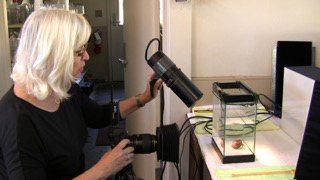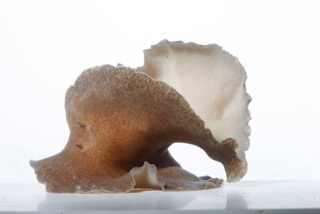Spineless: Art & Science Come Together at FHL
By Bernadette Holthuis
It was a low-tide summer morning and students of FHL’s Marine Invertebrate Zoology course, led by instructors Gustav Paulay and myself, were exploring a favorite shoreline site. Accompanying our class was photographer Susan Middleton, working on her latest project: a study of ocean invertebrates. Turning over rocks, we were delighted to come across a specimen of the locally rare Giant Flatworm (Kaburakia excelsa). Gustav held the animal out for students to see: a thin, seemingly featureless pancake, half the size of his palm and the color of mud. We slipped it into a jar to bring back to the Labs; there, Susan would photograph it before returning it to its home. I had my doubts that the creature, albeit interesting zoologically, would be particularly photogenic.
That summer of 2013 marked Susan’s fifth visit to FHL as a Whiteley Scholar, taking photographs of marine invertebrates in her signature style: portraits of individuals removed from their natural surroundings, starkly isolated on a white or black background. Her images — from the tropical Pacific as well as Friday Harbor — would form the body of a book whose goal was to not only educate, but also inspire feelings of connection to the animals portrayed and ultimately, support for ocean conservation.

Credit: Mary Piller
During each of her stints at FHL, Susan worked alongside the Marine Invertebrate Zoology courses in Lab 3, borrowing class study organisms to photograph in her makeshift studio. As she worked, students and instructors frequently drew her attention to particular animals that were small or well-camouflaged, with interesting features not immediately apparent, or with fascinating ecological or evolutionary stories. In turn, Susan captured them in ways we hadn’t seen them before. She sometimes spent hours or even days working with an individual in her studio aquarium, waiting for the organism to expand, to unfurl finely branched feeding tentacles or gills, or to exhibit behavior not normally seen. And while the rest of us usually viewed the animals from above, she offered a side perspective, at eye level or the equivalent.
For a popular audience, Susan’s images would reveal creatures unknown to many. Even viewers familiar with them from seashore explorations might not recognize the animals in their full glory: underwater, where soft, spineless organisms and their often delicate and diaphanous appendages are supported and vibrant.
Following the summer of 2013, I worked as scientific consultant and writer for the emerging book, identifying the species portrayed and composing short profiles about their natural histories. Spineless was released in the fall of 2014, with more than half its images taken in Lab 3 at the University of Washington’s Friday Harbor Laboratories; a subset of 50 photos formed the centerpiece exhibit at the San Juan Islands Museum of Art (IMA) during this past summer.

Credit: Susan Middleton
A Giant Flatworm photographed at FHL in 2013 received a two-page spread in the book and a 30x22” print in the exhibit: in a series of images, the worm performs a remarkable sequence of unexpected contortions, as if to defy any doubts that it is worthy of attention from Susan and the rest of us. Susan described it in her public lecture at the San Juan Community Theater (July 2015) as a flamenco dancer, and indeed, the worm seems to be dancing in her photos. This is just one example of Susan bringing out the best in the animals that she photographs. Pick up a copy of Spineless and enjoy!



